Behavioral Science II Lesson 3: Conformity and Obedience
1/39
There's no tags or description
Looks like no tags are added yet.
Name | Mastery | Learn | Test | Matching | Spaced |
|---|
No study sessions yet.
40 Terms
Jakob spends a lot of time with gangsters. Soon his parents start to notice that Jakob is dressing differently, doing drugs, and engaging in new illicit behaviors. Which term best describes Jakob's behavior?
(A) Group Polarization
(B) Conformity
(C) Group think
(D) Confirmation Bias
(B) Conformity
Conformity is known colloquially as "peer pressure" and is the tendency for individuals to bring their behavior in line with group norms. Jakob is conforming to be like his new group of friends.

CRB What is the name of the mechanism by which people conform to the group norms to avoid having their state of being disrupted by a threat of social rejection?
(A) Deindividuation
(B) Social Loafing
(C) Group Polarization
(D) Identity Shift Effect
(D) Identity Shift Effect
The Identity Shift Effect is how someone will often conform to group norms if their state of harmony is disrupted by a state of rejection.
You have no idea whether or not jumping off a 30-story bridge is dangerous or not, but your friend group assures you that it is not dangerous at all. You believe your friends and jump off the bridge. This is an example of ____________ Influence. If you had known that it was dangerous, but went ahead and jumped as to not look like a wimp, that would be an example of ______________ Influence.
(A) Normative, Informative
(B) Informative, Normative
(C) Public, Private
(D) Private, Public
(B) Informative, Normative
You have no idea whether or not jumping off a 30-story bridge is dangerous or not, but your friend group assures you that it is not dangerous at all. You believe your friends and jump off the bridge. This is an example of Informative Influence as you are looking to the group for guidance.
If you had known that it was dangerous, but went ahead and jumped as to not look like a wimp, that would be an example of Normative Influence as you are letting yourself be influenced by social norms.
Jimmy agrees to eat 10 hot chili peppers with his friends. How would Private Conformity play out in this situation? What about Public Conformity?
Private Conformity would entail Jimmy agreeing inwardly and outwardly that eating 10 hot chili peppers is a good idea.
Public Conformity would entail Jimmy eating the 10 hot chili peppers and agreeing that it is a good idea outwardly while feeling it is a bad idea inwardly.
The leadership team at Google decides that self-driving cars are so cool and will change the future forever. Whenever they encounter information to the contrary, they ignore it and whenever they encounter information to the affirmative, they believe it. Which term best describes the leadership team's behavior?
(A) Group Polarization
(B) Conformity
(C) Groupthink
(D) Confirmation Bias
(D) Confirmation Bias
This group is struggling with Confirmation Bias in which confirming information is believed while info to the contrary is dismissed.
The leadership team at Apple meets to discuss the new Apple Watch. Some members come to the meeting thinking that perhaps pink would be an awesome color for the new wrist band. By the end of the meeting, every team member strongly agrees that pink is the way to go. Which term best describes the leadership team's behavior?
(A) Group Polarization
(B) Conformity
(C) Groupthink
(D) Confirmation Bias
(A) Group Polarization
The team members left the meeting with a stronger conviction than before in the direction of the average group member's original opinion. This is in line with Group Polarization.
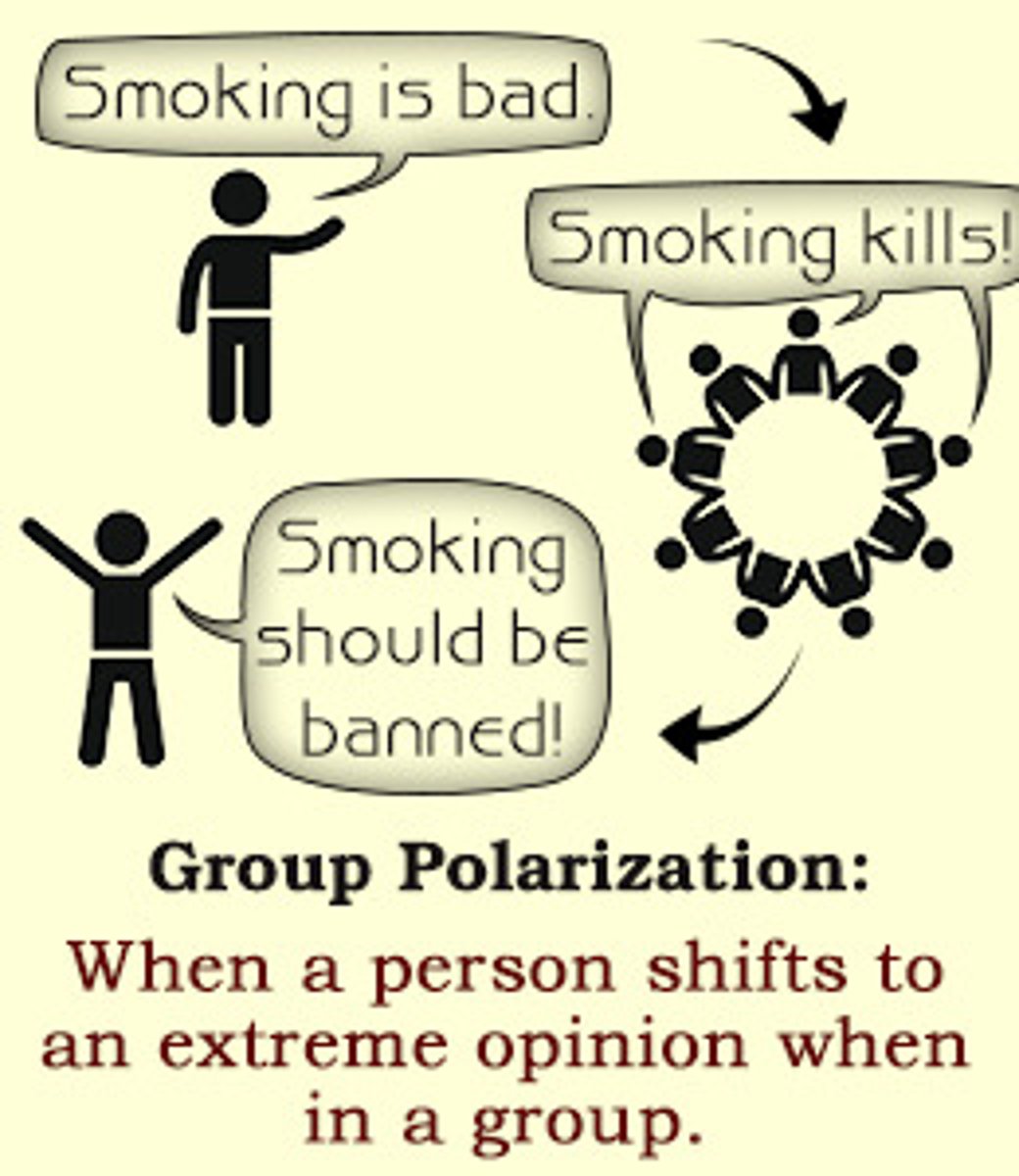
CRB Group polarization can be more complex than just this previous wrist band example. Which of the following statements are correct about Group Polarization?
I. For group polarization to occur, the underlying ideas are typically less extreme than the eventual consensus.
II. Risky choice best describes all group polarization consensuses, since these more extreme outcomes are riskier options.
III. Choice shift best describes behavior changes at the individual level, and could be either a shift towards risk or caution, depending on the group.
(A) I only
(B) III only
(C) I and II only
(D) I and III only
(A) I only
Each of the following is a correct statement about Group Polarization:
I. For group polarization to occur, the underlying ideas are typically less extreme than the eventual consensus.
II. Risky choice was an initial hypothesis since many group polarization consensuses choose behaviors are riskier options. There are also groups that could shift towards caution.
III. Choice shift best describes behavior changes at the Group level, and could be either a shift towards risk or caution, depending on the group. Polarization describes behavior changing on the individual level.
NASA met to discuss whether they should move forward with the Challenger launch. Those in opposition to the launch keep quiet. When those with a different opinion do speak up, they are censored. The group feels they are invincible and move forward with the launch. The launch fails, killing the astronauts involved. Which term best describes the leadership team's behavior?
(A) Group Polarization
(B) Conformity
(C) Groupthink
(D) Confirmation Bias
(C) Groupthink
Check out this video for more details on this classic case study of Groupthink: https://www.youtube.com/watch?v=OqTmSFkBqkg
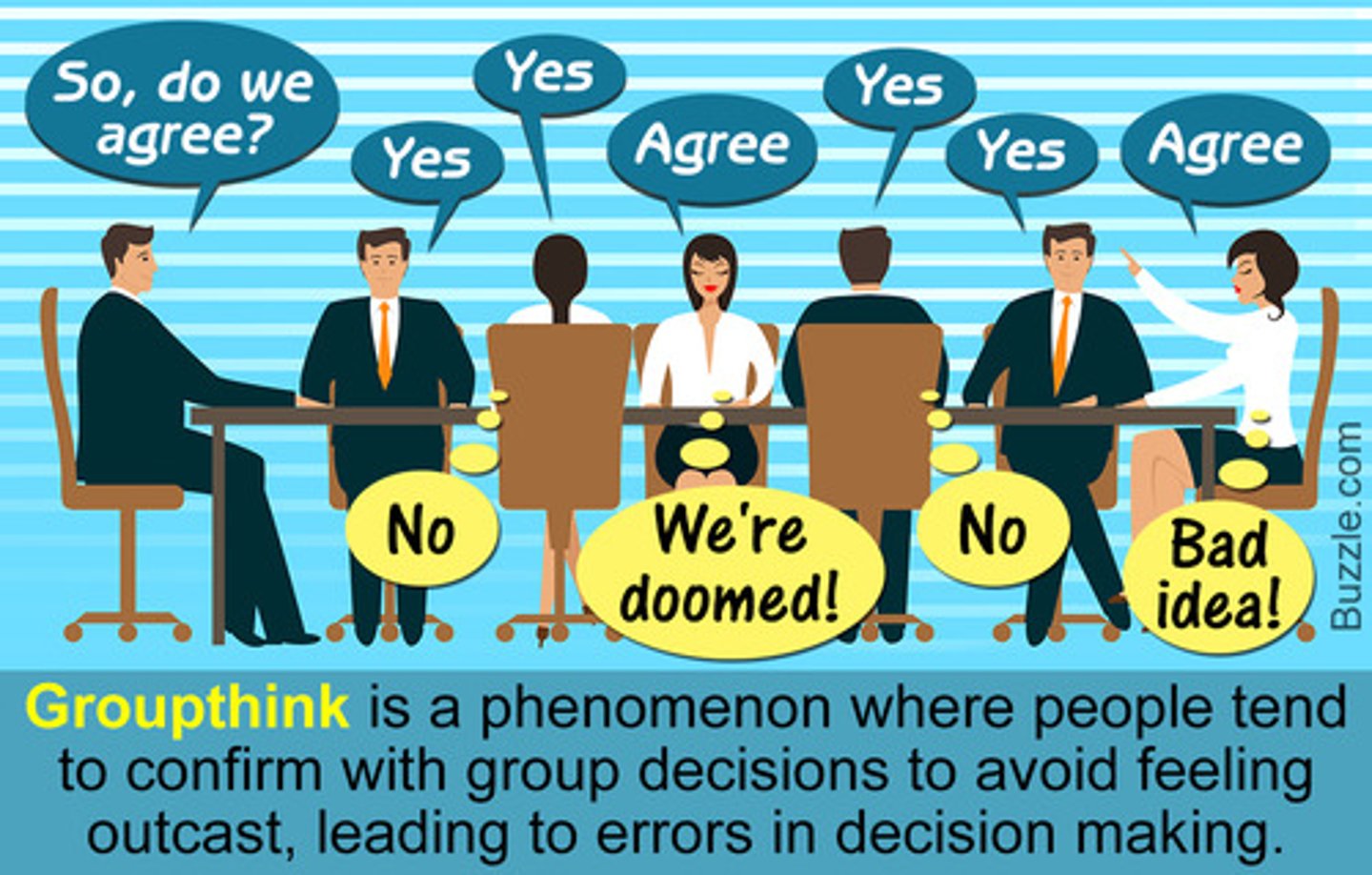
CRB Irving Janis was a landmark psychologist who started studying Groupthink, and identified eight factors that are indicative of Groupthink. Which of the following are NOT two of Janis' indicative factors of Groupthink?
(A) Illusion of Grandeur and Group Polarization
(B) Illusion of Invulnerability and Mindguards
(C) Illusion of Unanimity and Self-Censorship
(D) Illusion of Morality and Collective Rationalization
(A) Illusion of Grandeur and Group Polarization
The following are Irving Janis' indicative factors of groupthink:
I. Illusion of Invulnerability
II. Mindguards (appointment of members to protect against opposing views)
III. Illusion of Unanimity
IV. Self-Censorship
V. Illusion of Morality
VI. Collective Rationalization
VII. Excessive Stereotyping
VIII. Pressure for Conformity
CRB Part of what sparked Janis' investigation of Groupthink were formative historical events in the past 300 years or so. Which of the following events could easily be classified as Groupthink, based on Janis' eight characteristics?
I. The Bay of Pigs Invasion
II. McCarthy and the Red Scare
III. The Enlightenment
(A) II only
(B) I and II only
(C) I and III only
(D) I, II and III
(B) I and II only
Based on Janis' eight characteristics of Groupthink, the Bay of Pigs Invasion and the Red Scare could both be labeled as Groupthink. The French Enlightenment comes up in many CARS passages, and was known for an explosion of diverse thought, far from pressure for conformity to previous ways of thinking!
Jack always wears black to look like his favorite Green Day band members. He is demonstrated which of the following?
(A) Identification
(B) Compliance
(C) Conformity
(D) Internalization
(A) Identification
Jack is doing what he is doing because he respects and looks up to Green Day. This is what is seen in Identification.

Jeremy doesn't initially agree with the ideology of the KKK. After attending their meetings with his friends for some time, however, he begins to agree with their values. Even after his friends stop attending the meetings, Jeremy keeps attending and is an avid supporter. Jeremy has fallen prey to which term?
(A) Identification
(B) Compliance
(C) Conformity
(D) Internalization
(D) Internalization
Jeremy has internalized the values of the group over time, which is in line with Internalization.

CRB Compare Foot-in-the-Door and Door-in-the-Face Techniques, which are two notable techniques to gain compliance of others. Think of examples relating to Girl Scout Cookies!
Foot-in-the-Door Technique starts off by asking for a small favor, and then increasing it. Since the person has done favors in the past, they may be more receptive to doing this larger task. This could be the Girl Scouts asking you to buy a box of cookies one year, and the next year asking if you could buy a handful of boxes.
Door-in-the-Face technique is the opposite, asking for a big favor first and then following it up with a smaller request. The smaller request will sound more reasonable, and the person is more likely to accept it than just being asked that one task initially. This could be asking a Girl Scout mother to become the Troop Leader, and following it up by just asking her to organize a table outside the supermarket one day for selling cookies with the troop.
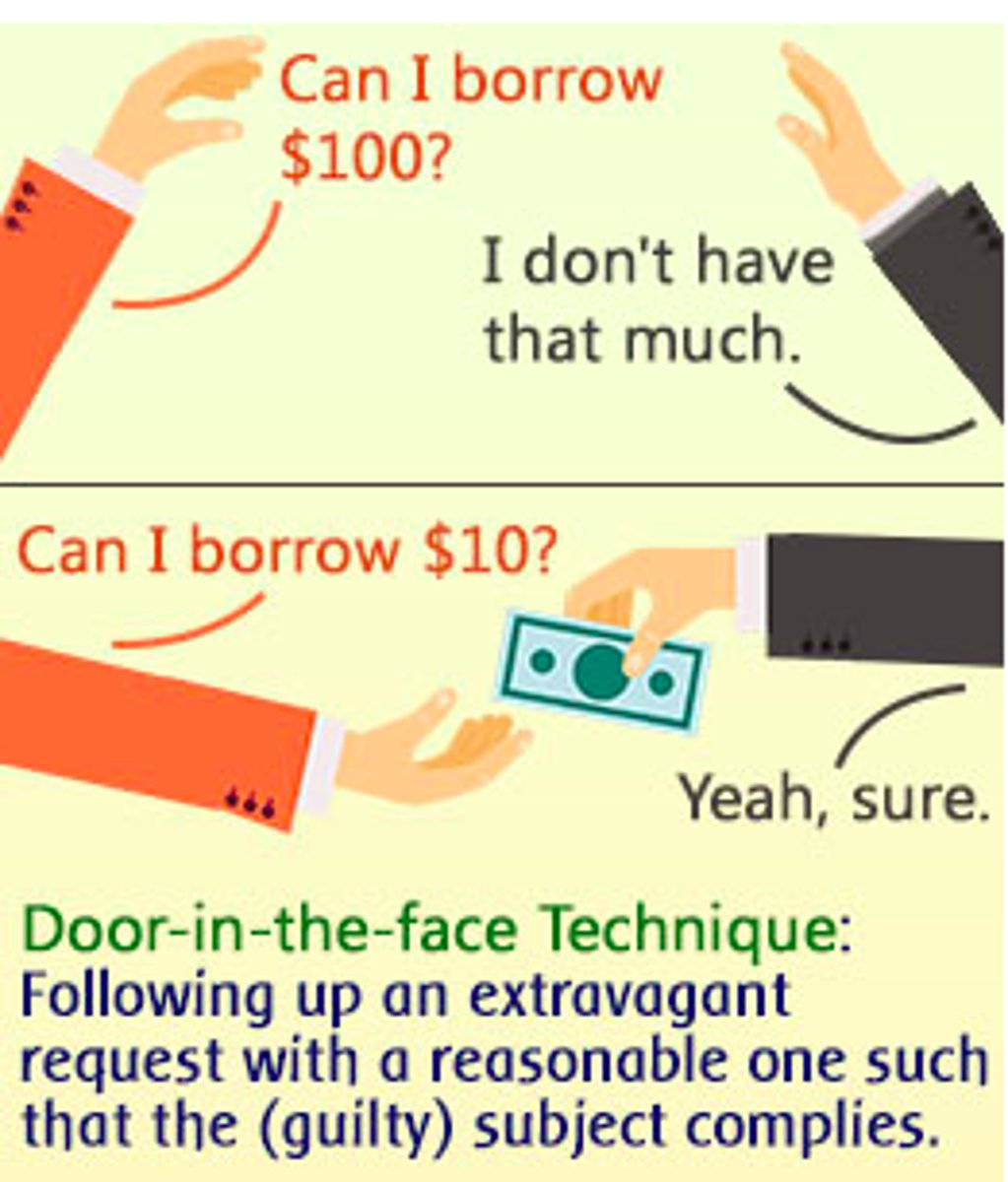
CRB Which technique is best described as someone wanting to avoid wasting effort, so they feel a pressure to continue doing a task they have started?
(A) Justification of Effort
(B) Public Declaration
(C) Foot-In-The-Door Technique
(D) Resolving Cognitive Dissonance
(A) Justification of Effort
Justification of Effort could make someone feel pressured into continuing down a path they have been working for, like "sucking it up" and finishing a particular major instead of switching majors and potentially needing to stay an extra year at school. It can also be taken advantage of by the Foot-in-the-Door Technique, as the person wants to justify all of the work they have been doing!
CRB One doctor has been struggling between two different diagnoses for a patient. Before giving the patient their diagnosis, the doctor picked one of the two diagnoses and told a floor secretary, a nurse, and a resident his diagnosis and reasoning behind it. After each conversation, the doctor felt more sure of their diagnosis and confidently believed it as they told the patient. Which technique did the doctor just use?
(A) Justification of Effort
(B) Public Declaration
(C) Foot-In-The-Door Technique
(D) Resolving Cognitive Dissonance
(B) Public Declaration
In Public Declarations, someone may feel uncertain when they first start talking through a particular position, but the more that they express themselves on that position, the more firmly they believe this. Public Declarations like these could also be used by politicians to convince themselves of their stances on the issues, believing more firmly in them after talking about them many times.
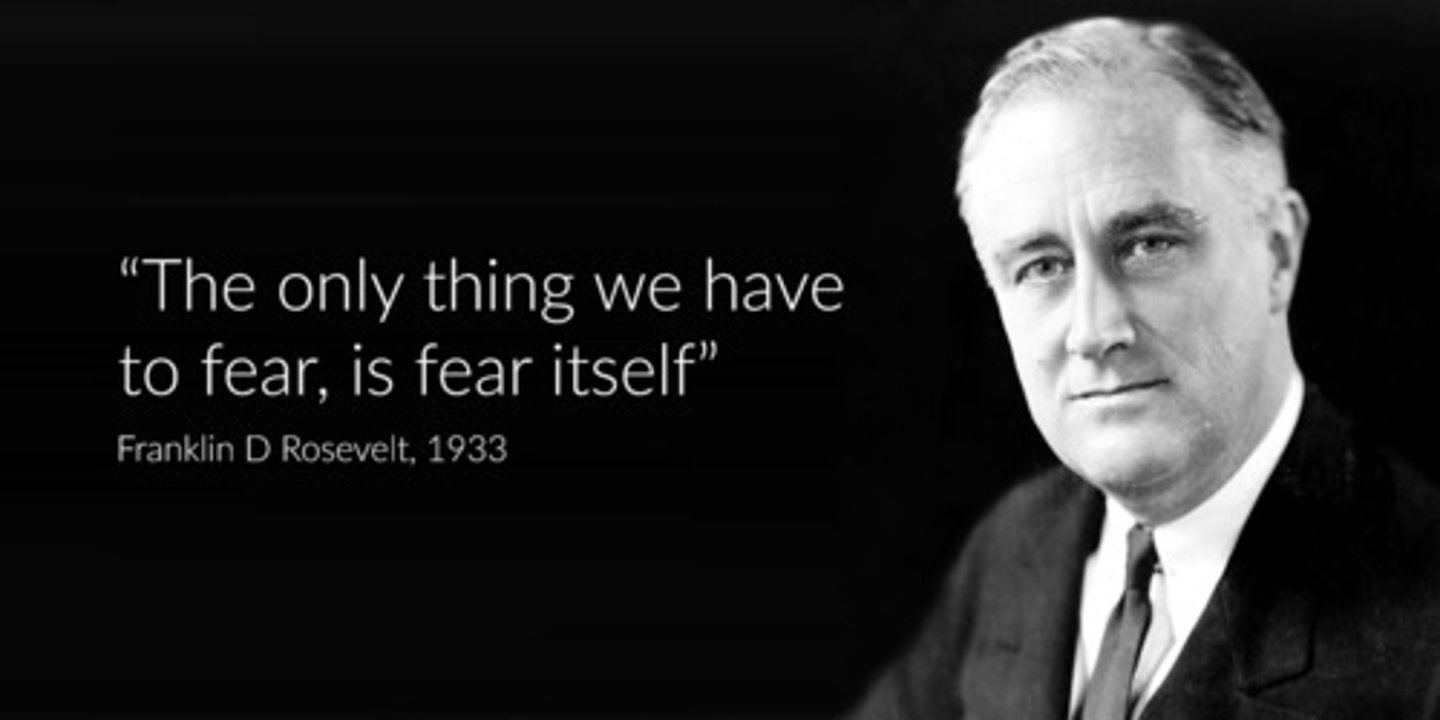
CRB One way that negotiators will try to achieve compliance is to get an initial commitment from someone, but then raise the cost (money or time or effort) needed for the commitment. Which term best describes this technique?
(A) Lowball Technique
(B) Riders Technique
(C) Pork Barrel Technique
(D) That's-Not-All Technique
(A) Lowball Technique
The Lowball technique describes a reasonable initial commitment from some party that then has its commitment increased after the commitment has been made. An example of this could be signing up to table at a fundraiser, and later being told you must write a report about the day's event to put out as publicity for the event.
CRB Another compliance technique is often used by companies that market on QVC or other television stations. One party will be given an offer, and before they can adequately judge the offer, the offered deal is improved by adding something else onto the deal. Which term best describes this technique?
(A) Lowball Technique
(B) Riders Technique
(C) Pork Barrel Technique
(D) That's-Not-All Technique
(D) That's-Not-All Technique
The That's-Not-All Technique describes this type of scenario. You probably encounter this scenario daily, as many advertisers try to use this technique!
Pork Barrel Legislation and Riders are two terms relating to Legislation.
Describe the difference between Conformity, Compliance, and Obedience.
Obedience is when you obey an authority.
Compliance is doing as you are asked even when you don't want to.
Conformity is when you go along with a group of peers.
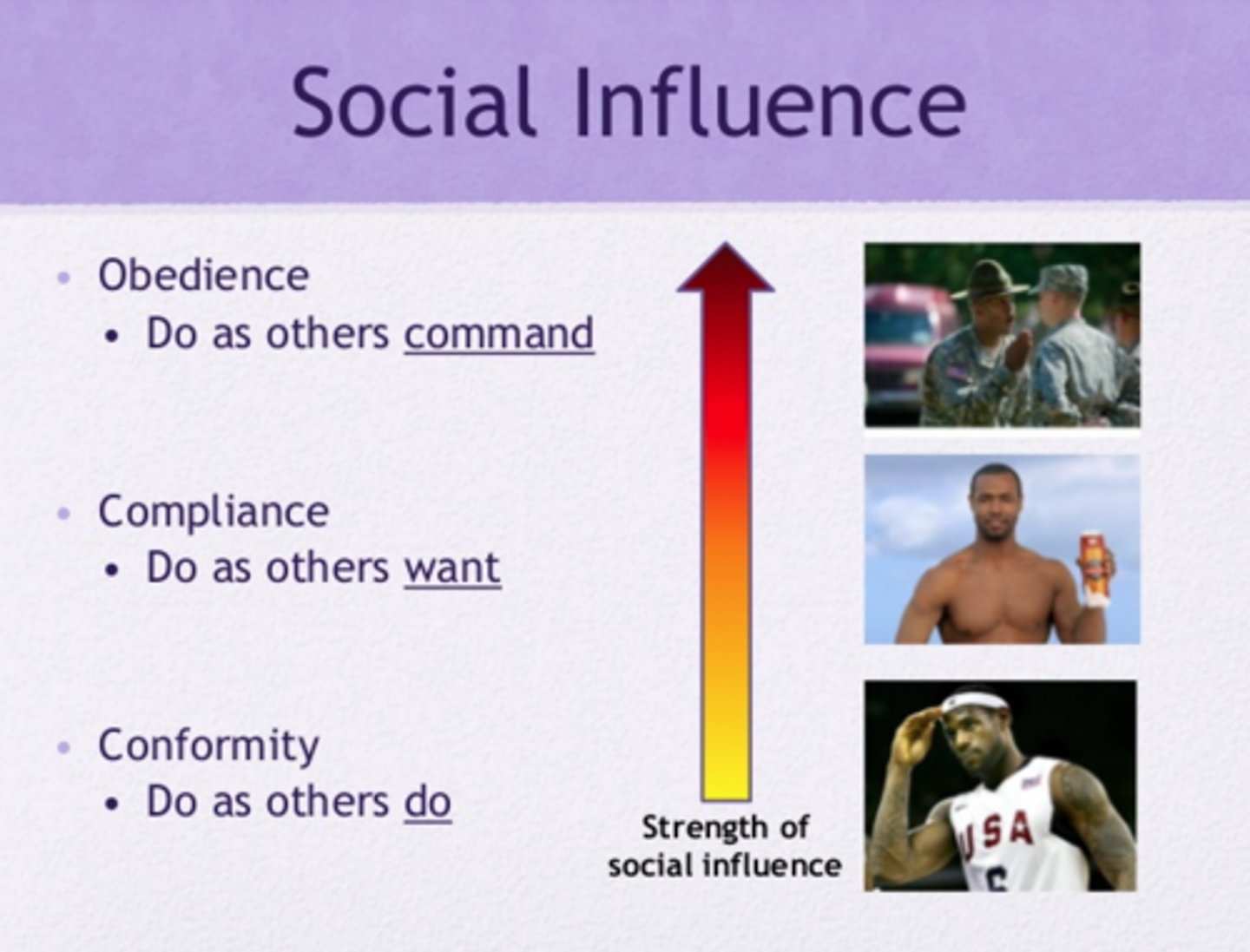
True or False? Gestalt Psychologists believe that you cannot understand human psychology by breaking it down into its parts. Rather it must be understood as a whole.
True. Gestalt Psychologists believe that you cannot understand human psychology by breaking it down into its parts. Rather it must be understood as a whole.

Who of the following can be considered Gestalt Psychologists?
I. Solomon Asch
II. Carl Jung
III. Stanley Milgram
(A) I Only
(B) I and II Only
(C) I and III Only
(D) II and III Only
(A) I Only
Solomon Asch was a Gestalt Psychologist.
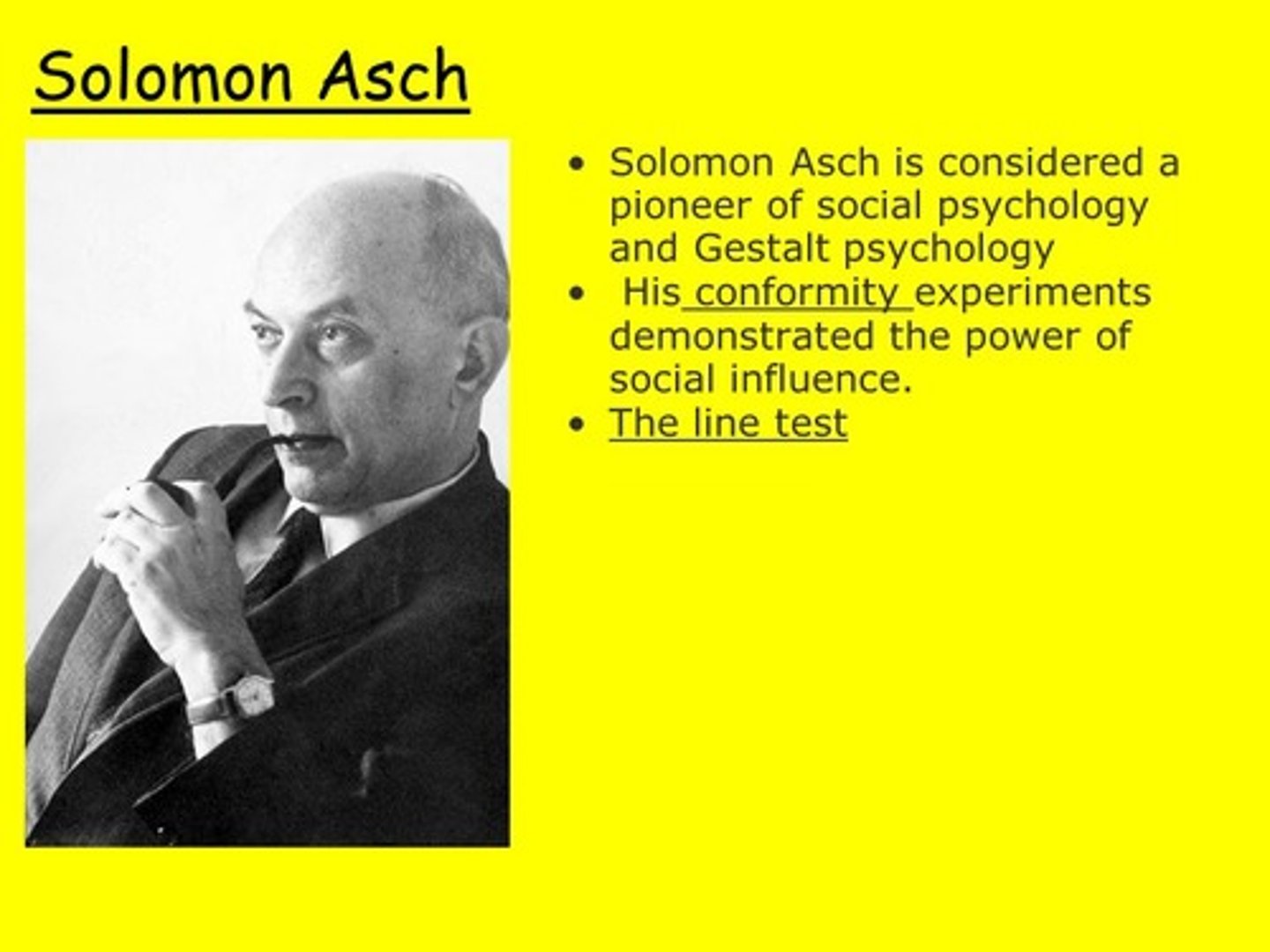
Describe the Solomon Asch Conformity Study.
People are asked to identify which line (A, B, or C) is equal to the line of interest. Only one person is actually a participant, and they are found to go along with the group even when they knew the group was wrong. The participant went along with the group at least once 75 percent of the time. The participant went along with the group every time 37 percent of the time. When alone however, the participant made errors less than 1 percent of the time!

In the Solomon Asch conformity study, some participants observed that cohorts gave an answer that seemed incorrect, but convinced themselves the group must be right and gave the group's answer, believing it is right. Which of the following is this an example of?
(A) Normative Social Influence
(B) Societal Influence
(C) Informational Social Influence
(D) Perceptual Error
(C). Because the participant correctly perceived the right answer but was convinced before answering the group was right, this exemplifies Informational Social Influence.
In normative social influence, the participant believes the group is wrong, but provides that same wrong answer to avoid ridicule.
In perceptual error, the participant actually concludes a wrong answer from the information provided, not due to group influence.
Societal Influence is a fictitious answer.
Some people argue that Solomon Asch's experiment is not generalizable to everyday situations in which there are incentives to conform with a group. This refers to which experimental error?
(A) Demand Characteristics
(B) Sampling Error
(C) Ecological Validity
(D) Double-blind Bias
(C) Ecological Validity
These people are questioning the Ecological Validity of the study, the degree to which it applies to the real world.
Sampling Error refers to the unrepresentativeness of the sample, in this case mostly college students.
Demand Characteristics refers to participants trying to act in the way that they are expected to act in a study.
Double-blind Bias is a made up term.
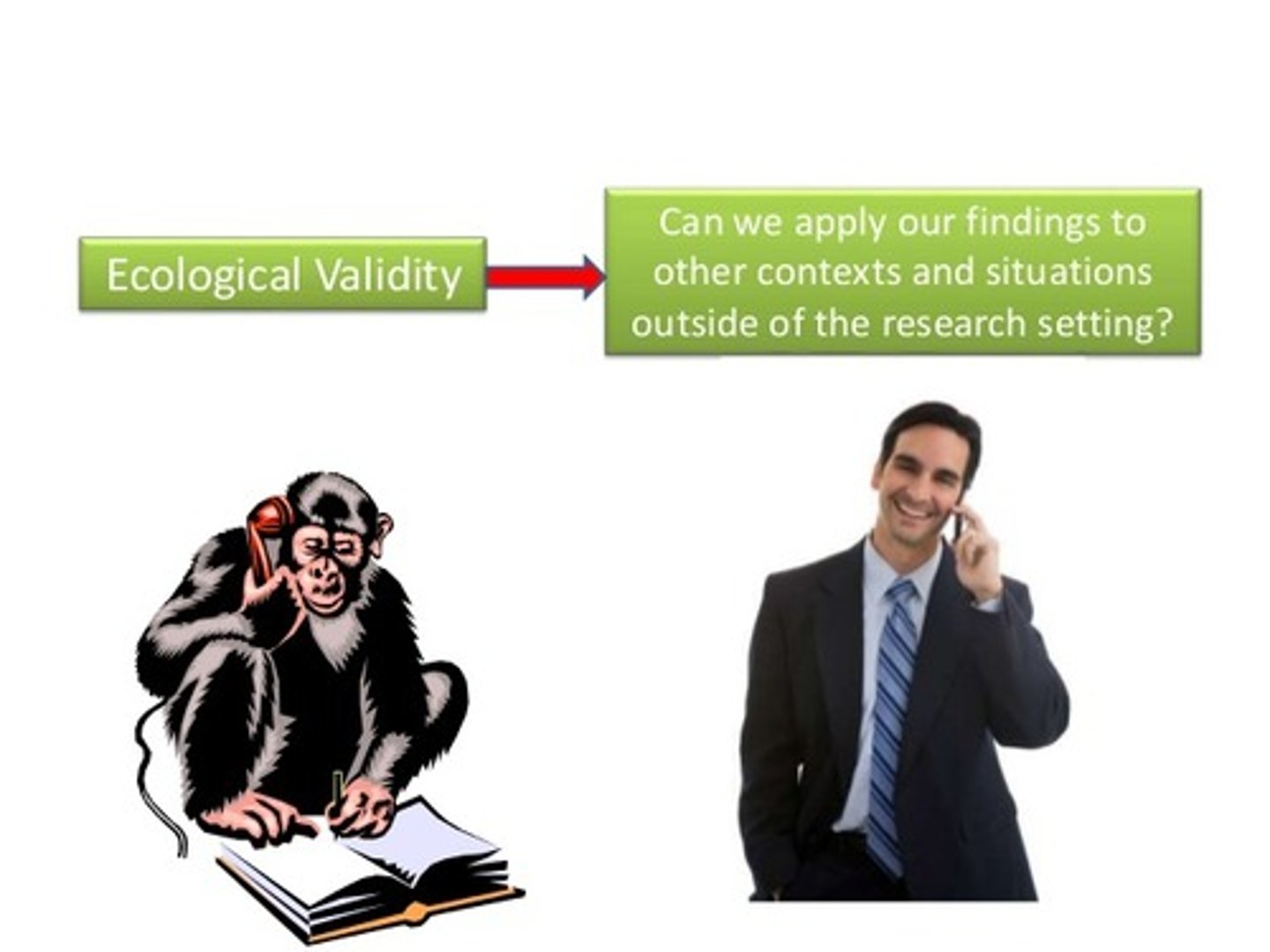
Describe the Milgram Experiment.
Participant is told to shock an individual for answering questions wrong. Individuals did as they were told and administered high level shocks in order to obey the authority. See this video for more info: https://www.youtube.com/watch?v=xOYLCy5PVgM
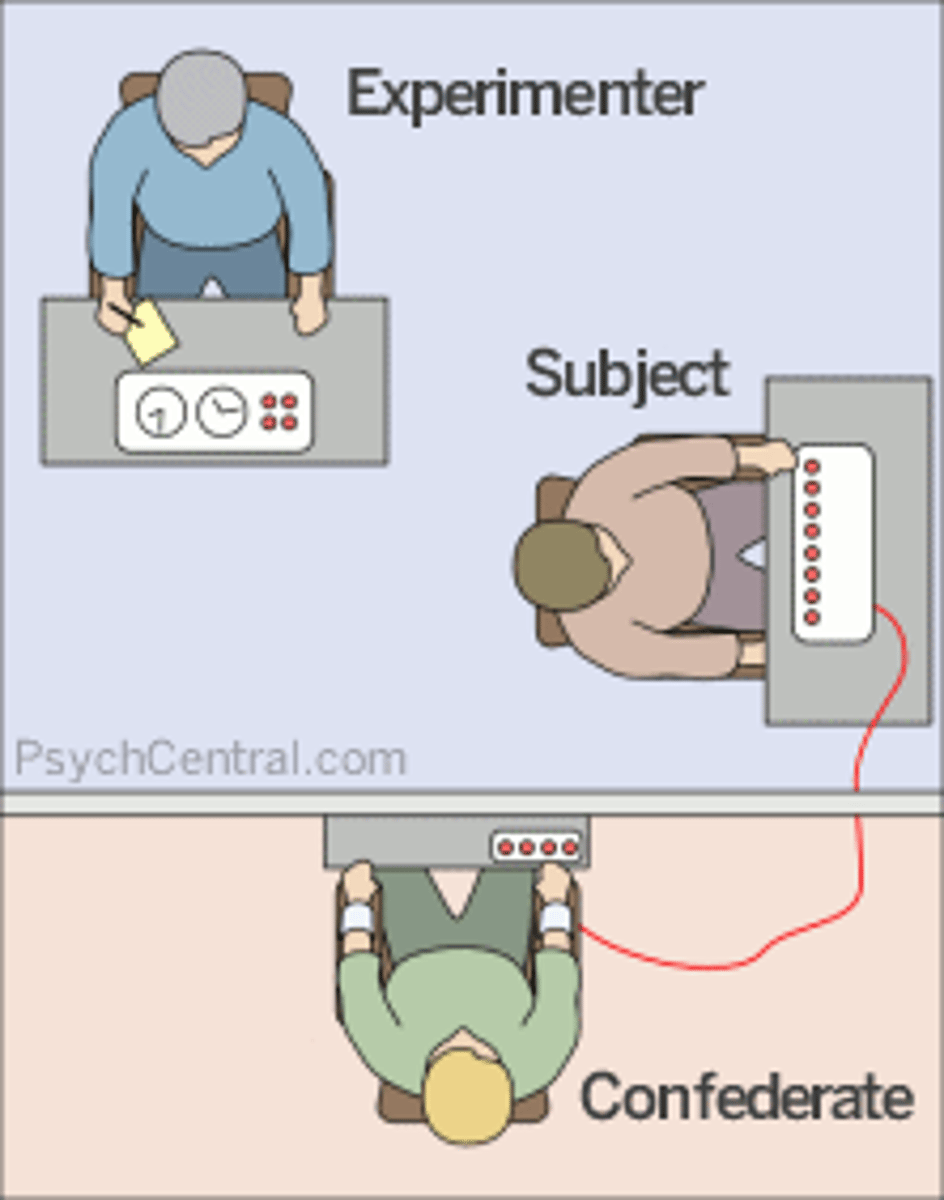
True or False. Milgram's study is considered ethical as evidenced by its many replications across cultures.
False. Milgram's study is considered unethical despite its many replications across cultures.
Jack sees a poor man on the street. He thinks to himself, "That poor fellow. He doesn't deserve this." Is this an example of the Just World Phenomenon?
This is not an example of the Just World Phenomenon. If it was, Jack would have said, "That fellow is getting what he deserves. He must be too lazy to get a job."
Think of the "Just World Phenomenon" as a "Fair World", and it can be used to justify critical judgments.
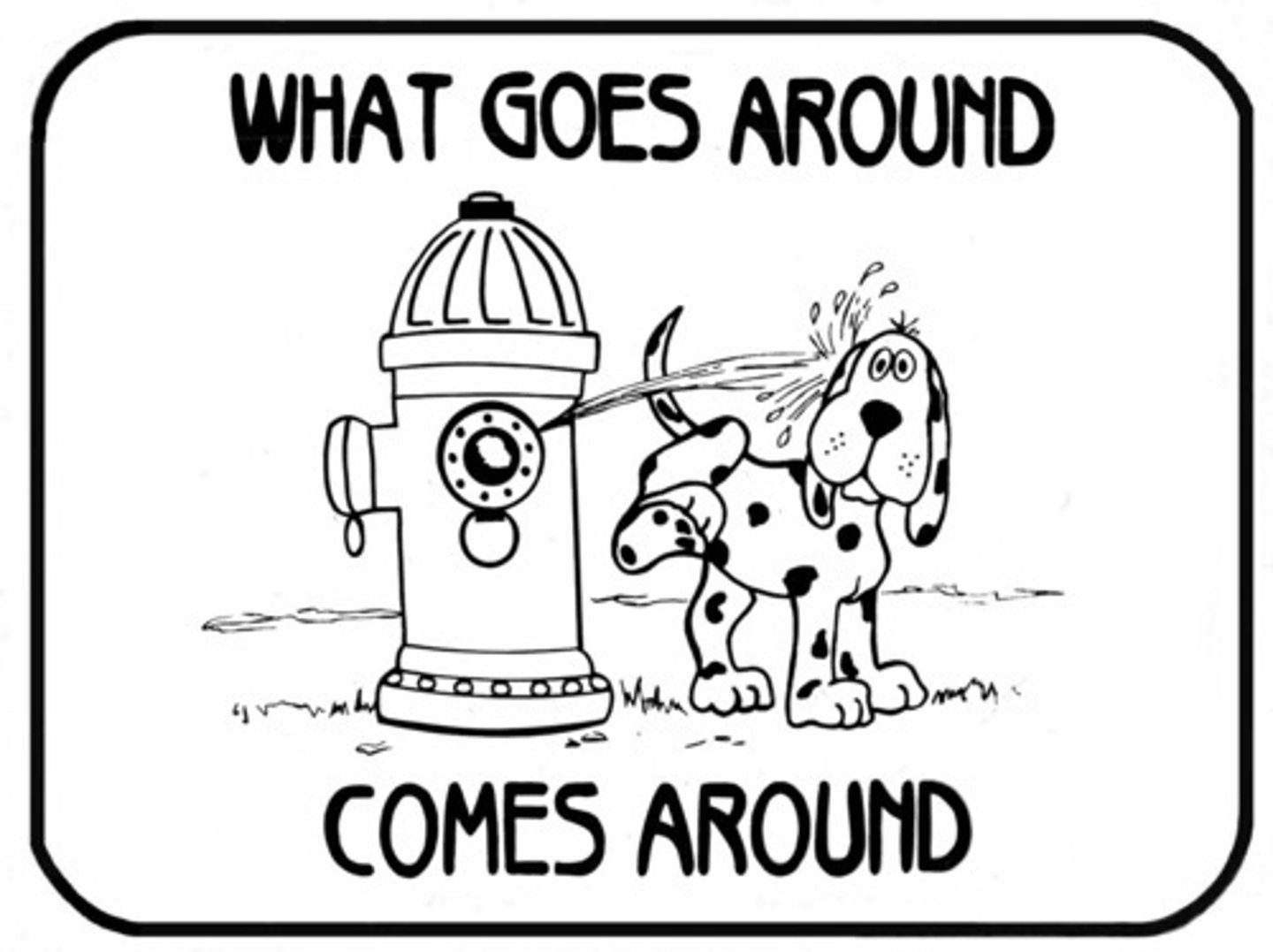
Jack looks back on the Holocaust, and thinks to himself, "If I were in that situation, I may have done the same thing." Is this an example of the Self-serving Bias?
This is not an example of the Self-serving Bias. Jack would have said, "I would have never done something like that", asserting his actions or morals would be superior.
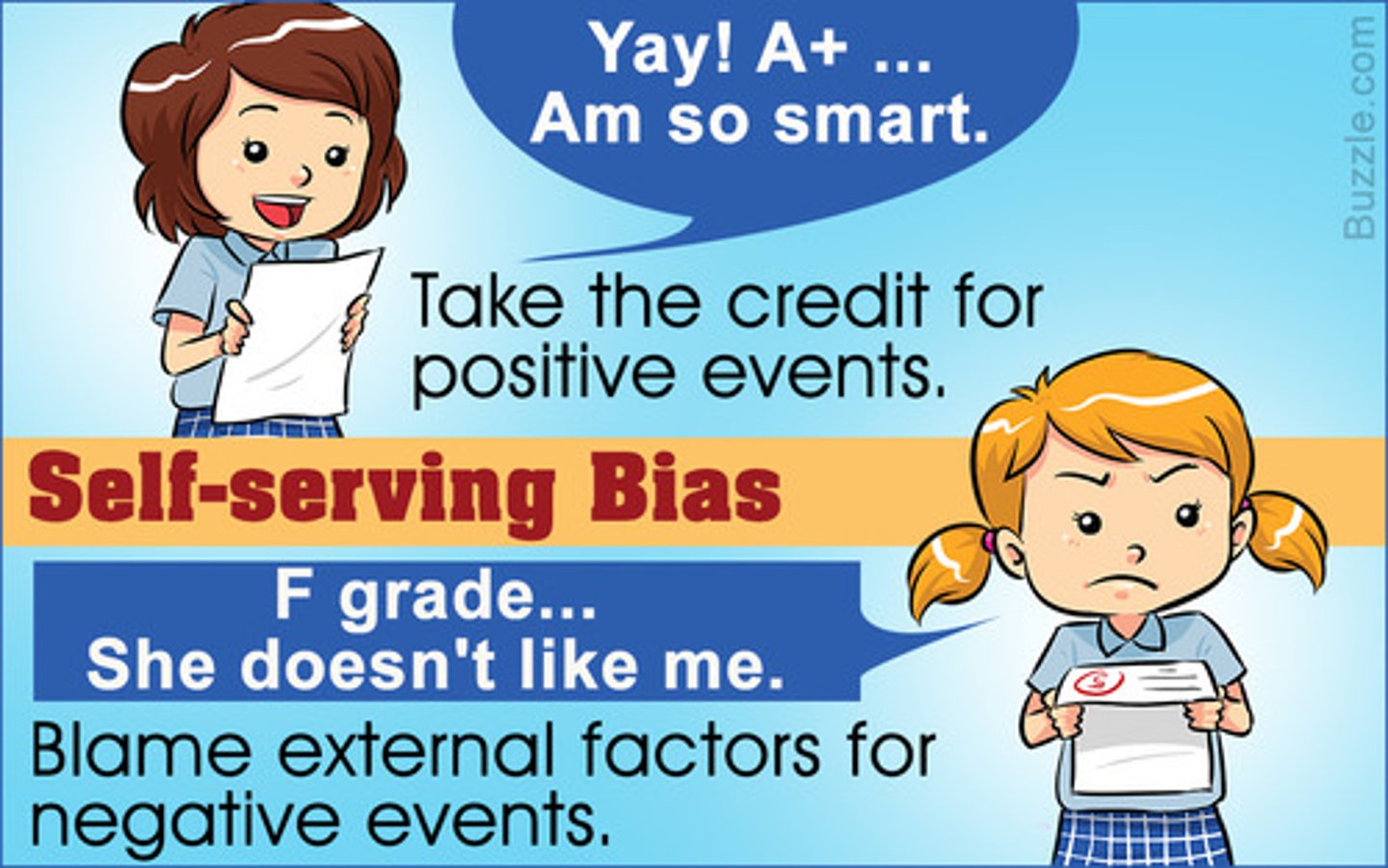
Describe the Zimbardo (Stanford) Prison Study.
College kids taken into a basement. Some were randomly made guards and the others made prisoners. The guards and prisoners started acting in accordance with their role so much so that the study had to be stopped. Zimbardo's Girlfriend had to convince Zimbardo to stop the study.

The guards lost their identity as college students as they became guards. This is an example of what?
(A) Deindividuation
(B) Cognitive Dissonance
(C) Fundamental Attribution Error
(D) Confirmation Bias
(A) Deindividuation
Deindividuation is when you feel less identifiable and so you engage in worse behavior. This is what happened with the guards.

CRB True or false? Antinormative Behavior also describes that worse behavior exhibited by the guards after deindividuation.
True. Antinormative Behavior also describes that worse behavior exhibited by the guards after deindividuation.
The guards told themselves that the prisoners deserved what they got. This allowed them to feel better about their brutal actions. This is an example of what?
(A) Deindividuation
(B) Cognitive Dissonance
(C) Fundamental Attribution Error
(D) Confirmation Bias
(B) Cognitive Dissonance
Cognitive Dissonance is when you change the way you think about a situation in order to avoid dissonance between your behavior and your beliefs. This is what the guards did to feel better about their actions.
Because the participants in the Zimbardo study knew this was an experiment, they acted the way that they thought Zimbardo wanted them to. This refers to which experimental error?
(A) Demand Characteristics
(B) Sampling Error
(C) Ecological Validity
(D) Double-blind Bias
(A) Demand Characteristics
Demand Characteristics refers to participants trying to act in the way that they are expected to act in a study.
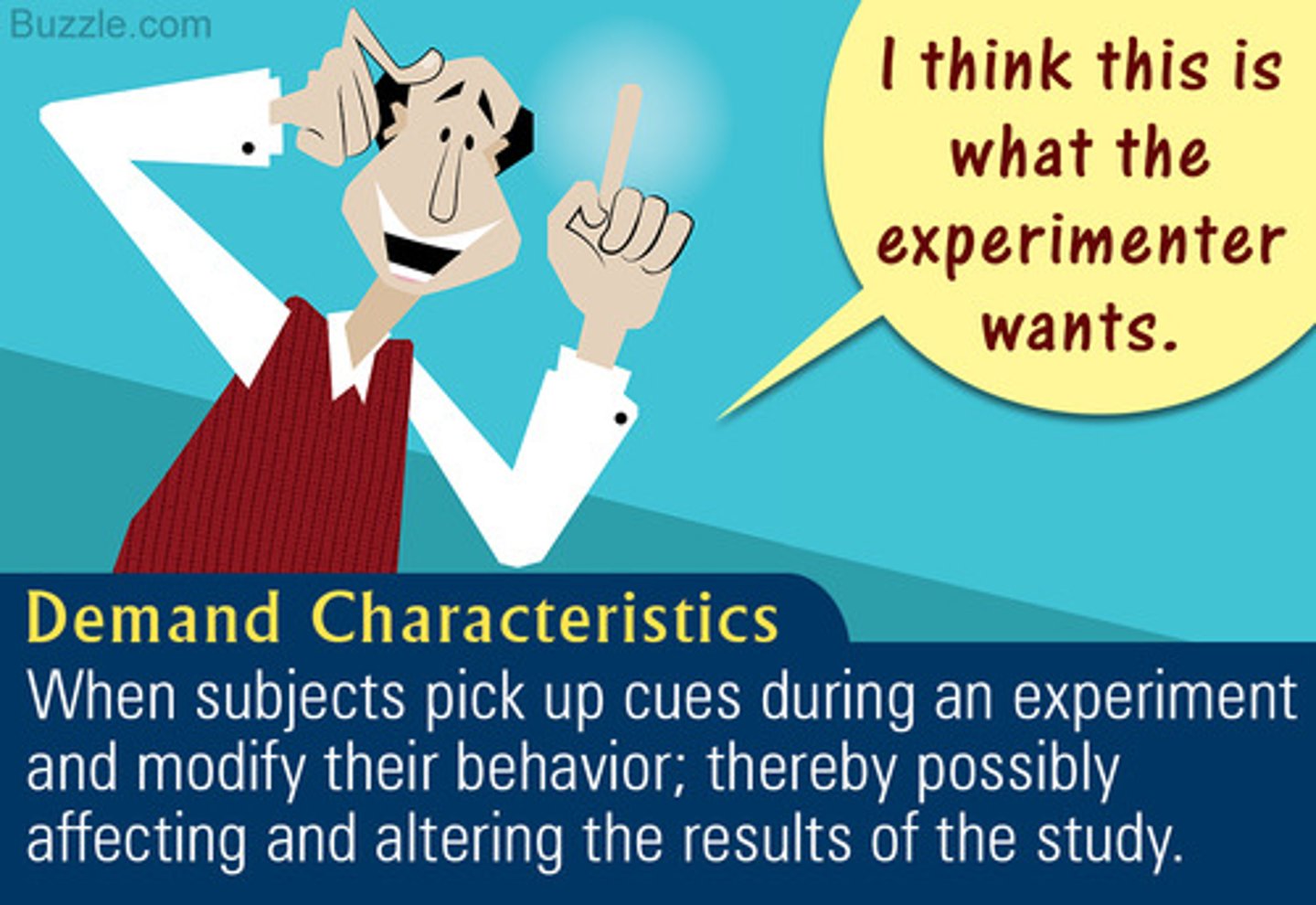
CRB Imagine that there was also a group of fifty onlookers with Zimbardo in his control room. Any one of the individuals would have confronted Zimbardo if they were alone, but they did nothing when in that large group. Which term best describes this effect?
(A) Peer Pressure
(B) Social Loafing
(C) Bystander Effect
(D) Social Facilitation
(C) Bystander Effect
The Bystander Effect best describes how this group of individuals would intervene if alone, but when in a big group, they do not act. Oftentimes, they expect somebody else would step up so they do not have to.
CRB Now imagine that a group of ten prisoners are being punished, and must carry heavy logs to burn for firewood. Most of these prisoners do not carry their fair share of the weight, or even close to their maximum weight they could carry. Which term best describes this effect?
(A) Peer Pressure
(B) Social Loafing
(C) Bystander Effect
(D) Social Facilitation
(B) Social Loafing
Social Loafing is a tendency of people to put in significantly less effort when in a group task or setting than if in smaller groups or alone.
True or False? The larger the group, the more likely you are to conform.
False. Conformity is strongest for groups of 3 to 5.
True or False? In the Asch experiment, when a supporter (one who answers correctly when the others didn't) was added, conformity of the participant increased because they didn't want to look stupid like the supporter.
False. Without a supporter, 37 percent of individuals answered in line with the group 100 percent of the time, but with a supporter, conformity dropped to just 5 percent. The more unanimous a group, the more likely you will be to conform.
True or False? In the Asch experiment, when the participant was told to write their answers down, conformity of the participant decreased because they no longer had to state a dissonant answer out loud.
True. In the Asch experiment, when the participant was told to write their answers down, conformity of the participant decreased because they no longer had to state a dissonant answer out loud. When you know you are not being observed, your conformity will decrease.
True or False? In the Milgram experiment, when the experimenter was standing right behind the participant, obedience of the participant decreased because they knew the experimenter more intimately.
False. In the Milgram experiment, when the experimenter was standing right behind the participant, obedience of the participant increased because obedience increases as physical proximity and closeness increase.
True or False? In the Milgram experiment, when the experimenter held a clipboard, obedience of the participant decreased because they knew the experimenter should have known better.
False. In the Milgram experiment, when the experimenter held a clipboard, obedience of the participant increased due to the increased authority of the person giving them the command.

True or False? There is a certain personality type that is more likely to obey and conform than others.
False. There isn't a certain personality type that is more likely to obey and conform than others.
However, different socioeconomic and cultural groups may be a little more likely.